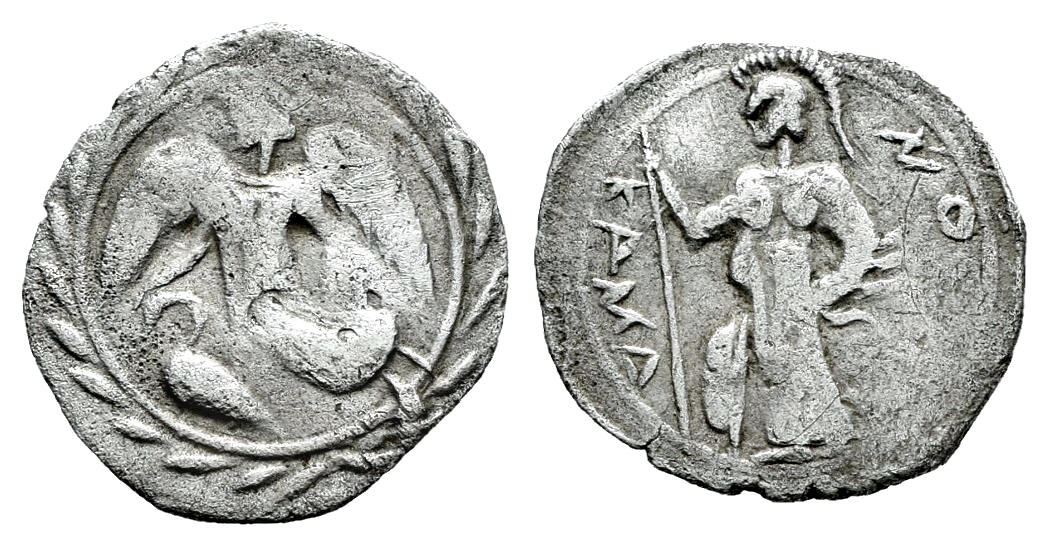Camarina, silver, litrai (460-450 BCE)
From SILVER
460 BCE - 450 BCE Silver 909 kg
Description
| ObverseInscription or printing placed on the obverse.: | Nike flying to left, below, swan to left, all within wreath |
| ReverseInscription or printing placed on the reverse.: | KAMAPINION (Greek).Athena standing to left, holding spear, shield set on ground at feet |
Mint and issuing power
| MintIdentifies the place of manufacture or issue of a numismatic object.: | Camarina | Ancient regionAncient region.: | Sicily | Modern countryModern country: Italy | AuthorityIdentifies the issuing power. The authority can be "pretended" when the name or the portrait of X is on the coin but he/she was not the issuing power. It can also be "uncertain" when there is no mention of X on the coin but he/she was the issuing power according to the historical sources: |
Chronology
| FromIdentifies the initial date in a range assigned in a numismatic context. | 460 BCE | toIdentifies the final date in a range assigned in a numismatic context.. | 450 BCE | PeriodTime period of the numismatic object.: Classical 480-323 BC |
Physical description
| MetalThe physical material (usually metal) from which an object is made.: | Silver |
Median weightMedian of the weights of numismatic objects (in grams). in grams | 0.70 | DenominationTerm indicating the value of a numismatic object. Examples: tetradrachm, chalkous, denarius.: | litra |
StandardStandard.: |
Image

AC 38 - Camarina, silver, litra, 460-450 BC.jpg [1]
References
| Die study referencePublication of the study: | Westermark - Jenkins 19801Westermark - Jenkins 1980, n° 10-129. | ||
| Coin series referenceReference to coin series study: | Sear I2Sear I, n° 757, RQEMAC3RQEMAC, n° 38, HGC 24HGC 2, n° 535 | ||
| Coin series web referenceCoin series web references: | |||
Obverse dies distribution
| FrequencyFrequency of specimen in distribution. ᵖ | Number of obversesNumber of obverse dies. ᵖ (o) | % (o) | Number of coinsNumber of coins. (n) | % (n) | Die nameName(s) of the die(s). |
| 1 | 18 | 31.58 | 18 | 7.14 | 4, 5, 6, 30, 31, 32, 34, 35, 36, 38, 40, 42, 43, 47, 48, 52, 54, 55 |
| 2 | 10 | 17.54 | 20 | 7.94 | 27, 28, 29, 33, 37, 39, 41, 44, 45, 49 |
| 3 | 5 | 8.77 | 15 | 5.95 | 1, 10, 26, 51, 57 |
| 4 | 5 | 8.77 | 20 | 7.94 | 7, 8, 11, 21, 56 |
| 5 | 3 | 5.26 | 15 | 5.95 | 13, 46, 50 |
| 6 | 1 | 1.75 | 6 | 2.38 | 9 |
| 7 | 3 | 5.26 | 21 | 8.33 | 12, 15, 17 |
| 8 | 2 | 3.51 | 16 | 6.35 | 18, 23 |
| 9 | 2 | 3.51 | 18 | 7.14 | 20;53 |
| 10 | 1 | 1.75 | 10 | 3.97 | 14 |
| 11 | 1 | 1.75 | 11 | 4.37 | 16 |
| 12 | 1 | 1.75 | 12 | 4.76 | 24 |
| 13 | 2 | 3.51 | 26 | 10.32 | 2, 19 |
| 14 | 2 | 3.51 | 28 | 11.11 | 3, 22 |
| 16 | 1 | 1.75 | 16 | 6.35 | 25 |
| Total | 57 of 57 | 99.97 | 252 of 252 | 100 |
Reverse dies distribution
no distribution is available
Quantification
| Number of obversesNumber of obverse dies. ᵖ (o) | 57 | Number of singletons (o1)The number of singleton coins. ᵖ | 18 |
| Number of reverse diesNumber of reverse dies. (r) | 83 | Number of coinsNumber of coins. (n) | 252 |
| Coins per obverse dieNumber of coins per obverse die. (n/o) | 4.42 | Coins per reverse dieNumber of coins per reverse die. (n/r) | 3.04 |
| Reverse per obverse ratioRatio of obverse dies divided by reverse dies. (r/o) | 1.46 | Percentage of singletons (o1)number of coins (n) divided by the number of singletons (o1) ᵖ | 31.58 % |
| Original number of dies (O) (Carter 1983 formula)The estimation of the number of coins according to Carter 1983 ᵖ | 64.9 | Coins struck if 20,000 as average productivity per dieCoins made if the average productivity for obverses (according to Carter) is 20,000. ᵖ | 1,298,000 |
| Original number of dies (O) (Esty 2011 formula)The estimation of the number of coins according to the singleton formula in Esty 2011 ᵖ (O) | 73.66 | Survival rate if 20,000 as average productivity per dieSurvival rate if average productivity is 20,000. ᵖ | 0.00019 |
| Coverage (o = % of O) (Esty 1984 formula)Esty 1984 - coverage (% of O) ᵖ (o = % of O) | 92.86% | Die productivity if survival rate 1/2,000Average productivity if survival rate is 1/2,000. ᵖ | 7,765.79 |
| Weight of silver (in kg) if 20,000 coins per die (O = Carter formula)Carter 1983 * Median weight * 20000 (*10 if gold or electrum) ᵖ | 909 kg <br /> 909 kg | Die productivity if survival rate 1/5,000Average productivity if survival rate is 1/5,000. ᵖ | 19,414.48 |
Remarks
Most likely one single workstation
References
- ^ Westermark, Ulla - Jenkins, Gilbert Kenneth (1980), The Coinage of Kamarina, RNS 9, Londres, 283 p., 40 pl.
- ^ Sear, David R. (1978), Greek coins and their values. Vol. I, Europe, London, xl, 316 p.
- ^ Callataÿ, François de (2003), Recueil quantitatif des émissions monétaires archaïques et classiques, Numismatique Romaine, Wetteren, VII + 267 p.
- ^ Hoover, Oliver D. (2012), The Handbook of Greek Coinage Series. 2. Handbook of the Coins of Sicily (Including Lipara). Civic, Royal, Siculo-Punic, and Romano-Sicilian Issues. Sixth to First Centuries BC, Lancaster-London, 489 p.